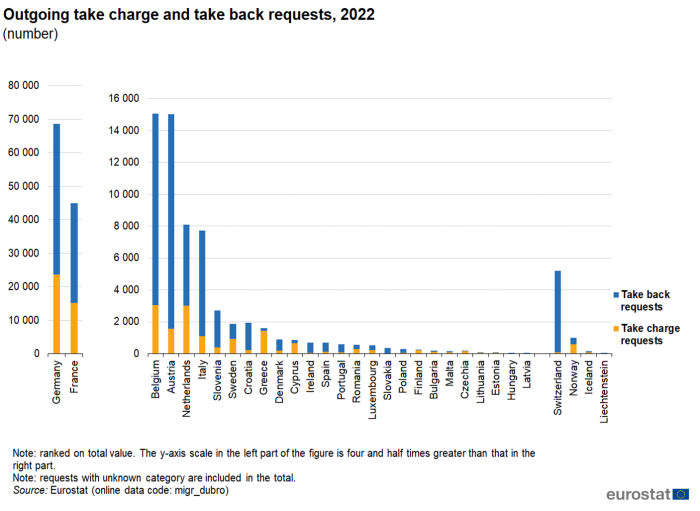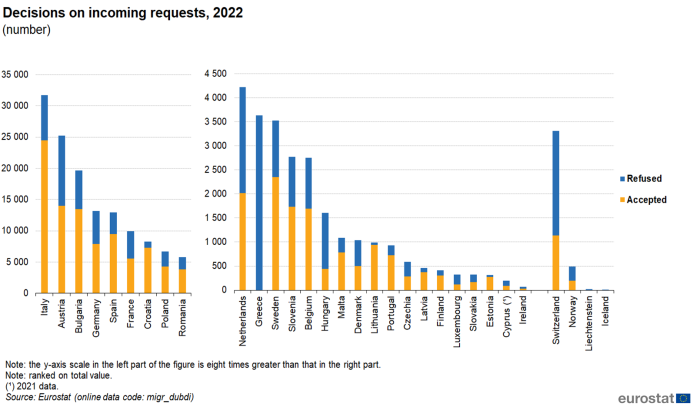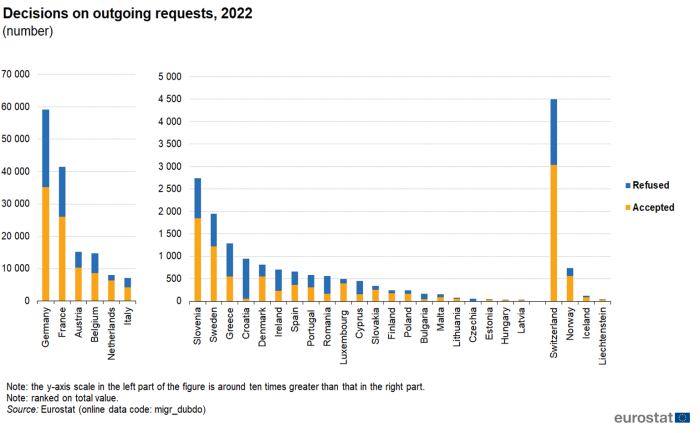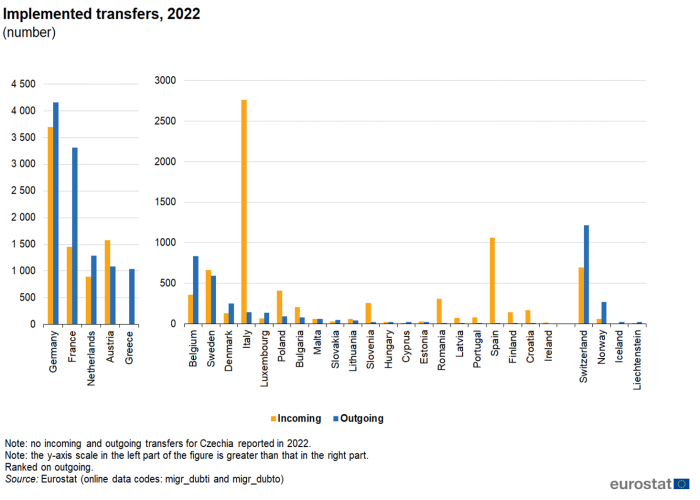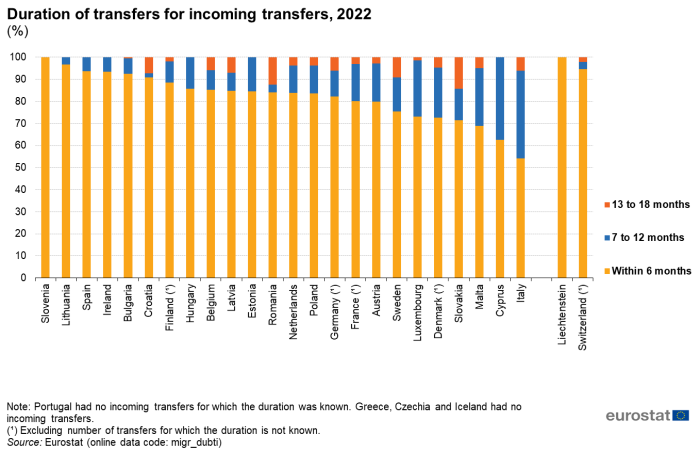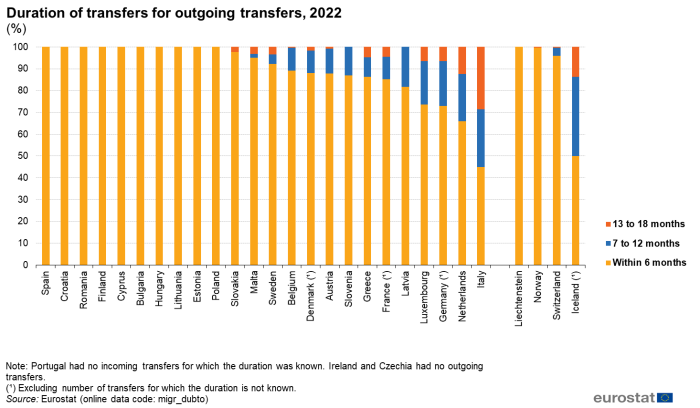Statistics on countries responsible for asylum applications (Dublin Regulation)
Data extracted in July 2023.
Planned article update: July 2024.
Highlights
In 2022, under the Dublin Regulation, Germany (68 706) and France (44 881) reported the largest number of outgoing requests to other EU Member States; the largest number of incoming requests was recorded by Italy (32 797), followed by Austria (24 455).
In 2022, Germany (59 059) and France (41 399) received the largest number of decisions on their outgoing requests; Italy (31 749) and Austria (25 210) made the largest number of decisions on incoming requests using the Dublin procedure.
In 2022, Germany and France recorded the largest number of transfers following the Dublin procedure: Germany reported 4 158 outgoing and 3 699 incoming transfers, while France reported 3 311 outgoing and 1 453 incoming transfers.
This article presents statistics on the implementation of Regulation (EU) No 604/2013 [1] (called hereafter 'Dublin Regulation') which aims at reducing consecutive transfers of asylum seekers from one EU Member State to another and at preventing abuse of the system by the submission of several applications for asylum by one person. Data[2] are provided for EU Member States and the European Free Trade Association (EFTA) countries.
The main principle is that only one EU Member State or EFTA country is responsible for examining an asylum application by a citizen of a non-EU country or by a stateless person. If during the course of the processing of an application the authorities in one EU Member State decide that the application should be dealt with in another Member State, the authorities of the former may make a request to the other Member State to take over responsibility of the asylum application (and consequently take over the applicant). Accordingly, the statistics refer to outgoing requests (Member States reporting requests sent out) and incoming requests (Member States reporting requests received).
Statistics presented in this article cover three main components related to the application of the Dublin Regulation: Dublin request (initial requests and re-examination requests), Decisions on Dublin requests (positive and negative) and Transfers following the acceptance of the requests. The Dublin request seeks to determine if another EU Member State has responsibility for examining the asylum application based on specific criteria outlined in the regulation. The purpose is to identify the EU Member State responsible for processing the application and potentially transferring the asylum seeker there.
Once a Dublin request is sent and the requested EU Member State agrees to examine the application, it issues a Decision on this request to the first Member State. The Dublin Decision request seeks to formally transfer the responsibility for processing the asylum application from the requesting EU Member State to the requested Member State.
Transfer requests are an integral part of the Dublin Regulation. Once the requested EU Member State agrees to assume responsibility for examining the asylum application, the requesting Member State will effectively transfer the respective person and the responsibility for processing his/her application from the requesting Member State to the responsible Member State.
This article describes the latest situation — data for 2022 — in relation to the numbers and types of requests. It also refers to subsequent stages in the procedure, namely decisions taken concerning requests, as well as any transfers of persons resulting from accepted requests to EU Member States, which accepted the responsibility to examine applications. It is important to note that in this article, the term 'requests' refer specifically to requests of asylum seekers sent by a Member State to another Member State under the Dublin regulation, excluding re-examinations.
The legal basis for the asylum data collection is the Regulation (EC) No 862/2007. The amendment to this regulation adopted in June 2020 introduced additional new statistics. It increased the additional level of detail of the statistics from reference year 2021, including information by sex and by accompanied and unaccompanied minors who represent a particularly vulnerable group seeking protection. The new statistics are already published in the Eurostat database and selected new data are included in this article.
Full article
Dublin requests
Incoming and outgoing Dublin request and re-examination requests in 2022
In 2022, the available data from EU Member States indicates that the majority of both incoming and outgoing Dublin requests focused on initial requests, with relatively low numbers of re-examination requests (see Figure 1). The incoming requests rates, varied from 79.8 % (Ireland) to 100 % (Portugal, Lithuania, Finland, and Greece), indicating a consistently low number of re-examination request. Notably, Spain (10.2 %), Hungary (16.7 %) and Ireland (20.2 %) had relatively higher re-examination request rates compared with the other countries, where incoming re-examination requests accounted for less than 10 % of total requests. For outgoing requests, the rates ranged from 74.2 % (Bulgaria) to 100 % (Latvia, Lithuania, Hungary, Portugal and Finland), indicating again a low level of re-examination requests following a negative reply on the initial request to the same EU Member State.
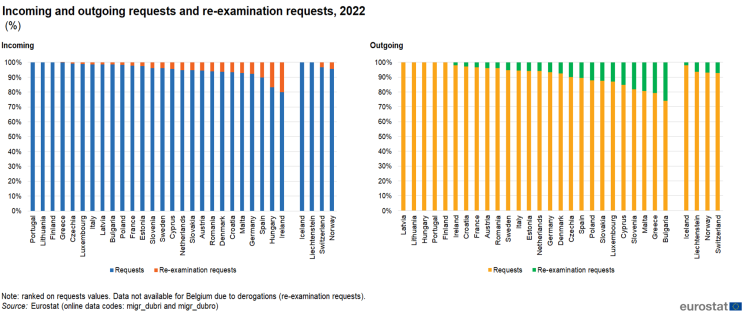
(%)
Source: Eurostat (migr_dubri) and (migr_dubro)
Incoming and outgoing Dublin requests in 2022
In the context of Dublin data, the incoming and outgoing requests specifically refer to requests of asylum seekers sent by an EU Member State to another Member State, excluding re-examination requests. In 2022, there were large disparities in incoming requests between EU Member States (see Figure 2), both in terms of how many requests were handled and in terms of the net requests received (the difference between the number of incoming and outgoing requests).
Seven EU Member States sent out fewer than 200 requests (outgoing requests): the three Baltic Member States (Estonia, Latvia and Lithuania), Bulgaria, Malta, Czechia and Hungary. A total of ten Member States sent between 200 and 1 000 requests, while six Member States sent between 1 000 and 10 000 requests. By far the largest numbers of outgoing requests were sent by Germany (68 706) and France (44 881).
Italy received the largest number of incoming requests in 2022, a total of 32 797, followed by Austria (24 455) and Bulgaria (20 051) which were the only other EU Member States to receive more than 20 000 requests. Nine of the Member States received less than 1 000 requests, among which Ireland received fewer than 100 requests (75 requests).
When combining data on the number of requests sent and the number of requests received (both shown in Figure 2), 20 Member States received more requests in 2022 than it sent. By contrast, seven Member States sent more requests than they received.
Incoming take charge and take back requests
There are two types of incoming and outgoing requests, namely take charge or take back requests. In the case of the take charge requests, the requesting country (the one sending the request) considers that the other EU Member State (receiving the request) should take over responsibility for examining the asylum application of an individual. In the case of take back requests, the asylum seeker (who is in the requesting country) has already submitted an application for asylum in the country receiving the request.
In 2022, in 17 Member States there were more take back than take charge requests, while the reverse situation was observed in the remaining ten Member States. The ratio of take back to take charge requests was particularly high in Greece, Austria and Bulgaria (127, 66 and 45 take back requests for each take charge request) and to a lesser extent in Slovenia (16:1) and Luxembourg (13:1) — see Figure 3. By contrast, more than 70 % of requests received in Finland (96.8 %), Czechia (93.8 %), Estonia (92.1 %), Spain (81.8 %) and Hungary (71 %) were take charge requests.
Reasons for incoming take charge and take back requests
The two pie charts in Figure 4 present the underlying reasons for taking charge or taking back requests. In 2022, the vast majority of incoming take charge requests received in EU Member States were related to irregular entry (57.9 %), documentation and legal entry (35.2 %) and family reasons (4.6 %); together these three categories accounted for over 97 % of all take charge requests.
For incoming take back requests, the lack of permission to stay for an asylum applicant (no residence permit) accounted for 92.6 % cases still under examination while 6.9 % had been rejected. The withdrawal of applications — either during the Dublin procedure or with new applications — made up only 0.4 % of reasons for incoming take back requests in the EU Member States.
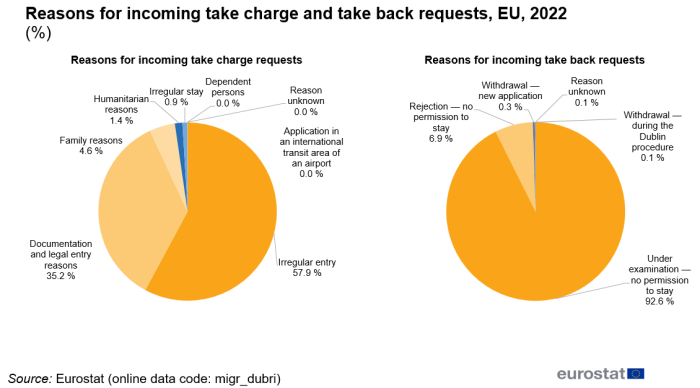
(%)
Source: Eurostat (migr_dubri)
Incoming requests by sex and by type of applicant
In recent years, there has been an increase in demand for more detailed Dublin statistics. The amendment to Regulation (EC) No 862/2007 introduced additional dimensions by sex and by type of applicant (adults, accompanied and unaccompanied minors). These additional data have been collected since the reference year 2021. Some EU Member States have derogations regarding the provision of these new breakdowns[3].
In 2022, in all countries, the incoming requests mainly concerned males. In Bulgaria, Austria, Romania, Slovakia and Slovenia the share of requests related to males accounted for over 90 %. The greatest share of requests that related to females (all over 35 %) were observed in Poland, Portugal, Croatia, Lithuania and Latvia. For the type of applicant, in only four Member States was the share of incoming requests related to unaccompanied minors above 10 %: Finland (22.2 %), Austria (19.5 %), Czechia (14.3 %) and Bulgaria (12.3 %).

Source: Eurostat (migr_dubri)
Outgoing take charge and take back requests
In 2022, the pattern — more take back than take charge requests — was observed in 17 EU Member States, while the reverse situation was seen in the remaining countries. The ratio of take back to take charge requests was particularly high in Slovakia, Ireland and Hungary— see Figure 6. By contrast, 90.8 % of requests sent from Czechia were take charge requests, with this share reaching 91.1 % in Finland, Latvia 94.4 % and 97.1 % in Lithuania.
Reasons for outgoing take charge and take back requests
In 2022, the vast majority of outgoing take charge requests sent in EU Member States were related to irregular entry (55.4 %), documentation and legal entry (35.6 %); together these two categories accounted for 9 out of 10 (91 %) take charge requests — see Figure 6. Nearly all outgoing take back requests sent in EU Member States were related to no permission to stay, either concerning applications under examination (90.7 %) or rejected ones (7.8 %).
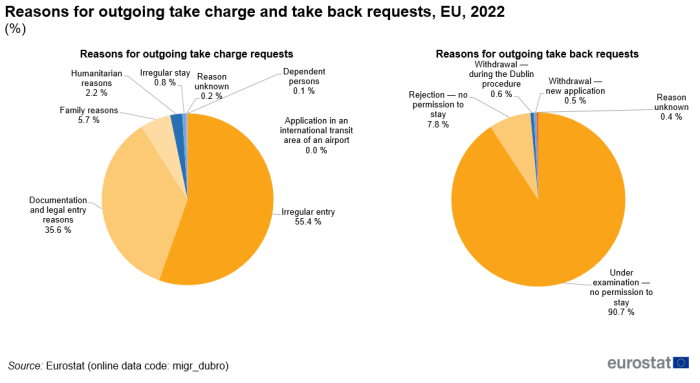
(%)
Source: Eurostat (migr_dubro)
Outgoing requests by sex and by type of applicant
In 2022, in Hungary there were no requests related to females, while in all other countries the outgoing requests concerned mostly males. The greatest shares of outgoing requests concerning females (all over 40 %) were observed in Estonia and Latvia. For the type of applicant, the share of outgoing requests related to unaccompanied minors was above 20 % only in four Member States: Cyprus (52.4 %), Bulgaria (51.4 %), Greece (37.1 %) and Austria (20.09 %). In Greece the share of requests that concerned minors (both accompanied and unaccompanied) accounted for 73 %, while in Cyprus, Bulgaria and Croatia it was respectively 52.4 %, 52 % and 43.3 %. In Portugal, all the outgoing requests were for adults.
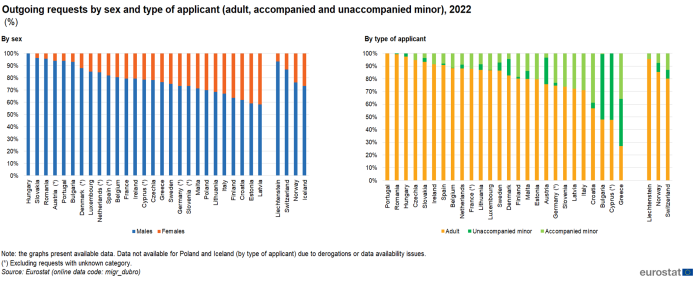
Source: Eurostat (migr_dubro)
Decisions on Dublin requests
Decisions on incoming and outgoing Dublin requests and re-examination requests in 2022
Decisions on incoming and outgoing requests involve decisions to take responsibility of a person to be sent by a Member State to another Member State. Re-examination requests, on the other hand, involve a subsequent review of a previously denied request. In Figure 9, which represents the decisions on requests and re-examination requests in 2022 for 22 EU Member States with available data, a significant majority of countries demonstrated a high percentage of decision requests, ranging from 90 % to 100 %. Only three countries, namely Spain (89.5 %), Hungary (83.2 %) and Ireland (80.4 %), fell slightly below the 90 % threshold.
For outgoing requests, 17 EU Member States out of 26 for which data are available displayed a high percentage of decision requests, ranging from 90 % to 100 %. However, there is a relatively small proportion of re-examination requests for outgoing requests, ranging from 0 % to 20 %. Notably, Czechia had the highest re-examination request rate at 65.1 % followed by Cyprus 21.4 %. Overall, the figures demonstrate that the number of decisions on re-examination requests was relatively low across most countries.
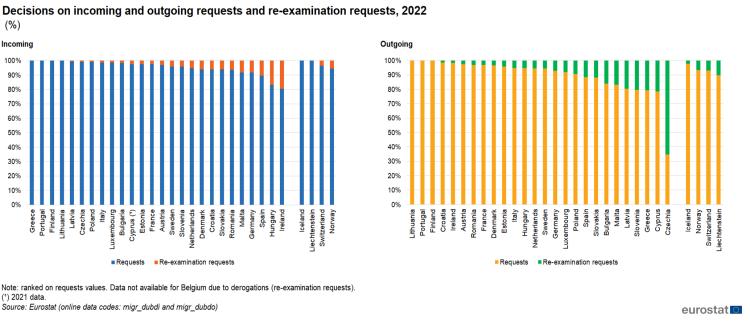
(%)
Source: Eurostat (migr_dubdi) and (migr_dubdo)
Accepted and rejected decisions
The number of decisions on incoming or outgoing requests is related to the number of requests (excluding the re-examination requests), although the decision on a particular request may be made in a different calendar year, especially if decisions are delayed [4]. Due to the relative volatility in the incoming and outgoing requests in EU Member States in recent years (related to the volatility in the number of asylum applicants) there could be substantial differences between the number of requests and the number of decisions in a single reporting year. In 2022, Italy (31 749) and Austria (25 210) made the largest number of decisions on incoming requests (see Figure 10), with Italy accepting 77 % of the requests it received and Austria 55.4 %. A further 15 EU Member States took more than 1 000 decisions on Dublin requests in 2022. Among the remaining nine Member States for which data are available, Ireland took the fewest decisions (74).
Looking at decisions on outgoing requests in 2022, Germany (59 059) and France (41 399) received the largest number of decisions (see Figure 11). A further seven EU Member States also received at least 1 000 decisions on their outgoing Dublin requests in 2022. Among the 18 remaining Member States, for which data are available, who received fewer than 1 000 decisions on their requests, Czechia, Hungary and the Baltic Member States received less than 100 decisions on their outgoing requests.
Implemented transfers
The final stage in the Dublin procedure, in case of acceptance of the request, is the actual transfer of responsibility for an asylum applicant from the requesting EU Member State to the Member State responsible. This implies the physical transfer of the person concerned from the requesting Member State to the partner country that has accepted the responsibility to take back or to take charge of that person. The transfer has to be carried out as soon as practically possible and at the latest within six months of acceptance of the request by the partner Member State. This time limit may be extended up to a maximum of one year if the transfer could not be carried out due to imprisonment of the person concerned, or up to a maximum of 18 months if the person concerned absconds.
Figure 12 refer to transfers effectively implemented in 2022, while Figures 13 and 14 provide information on the duration within which transfers took place once a decision had been taken.
In 2022, the largest numbers of outgoing transfers were recorded by Germany (4 158) and France (3 311) followed by the Netherlands (1 285) and Austria (1 084) (see Figure 12).
By far the largest number of incoming transfers was recorded by Germany (3 699), followed by Italy (2 763), Austria (1 574) and France (1 453), while Sweden, the Netherlands and Spain also recorded more than 500 incoming transfers each. Czechia had no incoming or outgoing transfers recorded for the reference year 2022.
The largest absolute differences between the numbers of incoming and outgoing transfers were recorded in France (1 858) and Greece (1 037) among those Member States with more outgoing transfers, and in Italy (2 623) and Spain (1 057) among those with more incoming transfers.
Figures 13 and 14 provide an analysis of the speed with which applicants were transferred, based on the time lag between a decision being taken and the person actually being transferred. Data are compiled for three durations, these corresponding to the various possibilities for the timing of transfers as laid down in the Dublin III Regulation: the transfer of the applicant from the requesting EU Member State shall be carried out in accordance with the national law of the requesting Member State and at the latest within six months of acceptance of the request; this time limit may be extended up to a maximum of one year if the transfer could not be carried out due to the imprisonment of the person concerned or up to a maximum of 18 months if the person concerned absconds.
In 2022, in Slovenia all the incoming transfers were completed within six months. In all the Member State, at least half of all incoming transfers were completed within six months. Italy had the greatest share of transfers completed between 7 and 12 months (39.7 %), while Slovakia and Romania had the largest shares of transfers completed between 13 and 18 months, respectively 14.3 % and 12.4 %.
For outgoing transfers (see Figure 14) Italy reported the least share of outgoing transfers completed within six months (45 %) of its 140 outgoing transfers. In fact, there were ten Member States where all (100 %) outgoing transfers were implemented within six months.
For more detailed information on implemented transfers by sex and type of applicant please refer to the Eurostat database.
Source data for tables and graphs
Data sources
The legal basis of data collection on migration and international protection (asylum) is Council Regulation (EC) No 862/2007 of 11 July 2007, which refers to the obligation to submit Dublin statistics (among other statistics on migration and international protection). The national data are provided by interior ministries (also known as ministries for internal or home affairs), statistical offices or agencies responsible for immigration.
Data are collected on an annual basis (calendar year) and must be transmitted by reporting countries no later than three months after the end of the reference period. The time series start with the 2008 reference year.
In relation to the new statistics by sex and by type of applicant presented in this article, derogations were granted to some Member States based on Commission Implementing Decision (EU) 2021/431 of 10 March 2021.
Data quality and comparability
Article 4.4 of Council Regulation (EC) No 862/2007 refers to statistics based on the number of requests. It is however recommended by Eurostat that data should be provided with respect to the number of persons concerned (by requests, decisions and transfers) as some requests may relate to more than one person. However, for technical reasons some countries supply statistics relating to the number of requests rather than persons.
Asymmetries exist between incoming requests received by one EU Member State and outgoing requests sent by another. Asymmetries may exist for a number of reasons.
EU Member States may record requests at different times — a few days apart, which may lead to some small asymmetries between one reporting year and the next.
The initial reason for a request may be changed by the EU Member State receiving the request if its investigation of the request shows that there is a different basis for accepting the request than that proposed by the requesting Member State. Such changes in the nature of the requests may not be fully reflected in the statistics reported by the requesting and receiving Member States.
As noted above, some EU Member States provide information for the number of requests and others for the number of persons and these differ in the case of multi-person requests.
Context
Background
Since 1999, the EU has focused on the creation of a common European asylum system (CEAS) and the improvement of the current legislative framework. Between 1999 and 2005, several legislative measures harmonising common minimum standards for asylum were adopted. This was followed by a Green Paper (COM(2007) 301 final) in 2007, a Policy plan on asylum (COM(2008) 360 final) in 2008 and subsequently a revision of the legislation underlying the system. The following legislative texts provide the main basis for the asylum system at the present time.
- The revised asylum procedures Directive aims at fairer, quicker and better quality asylum decisions. Asylum seekers with special needs will receive the necessary support to explain their claim and in particular there will be greater protection of unaccompanied minors and victims of torture.
- The revised reception conditions Directive ensures that there are humane material reception conditions (such as housing) for asylum seekers across the EU and that the fundamental rights of the concerned persons are fully respected. It also ensures that detention is only applied as a measure of last resort.
- The revised Dublin Regulation enhances the protection of asylum seekers during the process of establishing the EU Member State responsible for examining the application, and clarifies the rules governing the relations between Member States. It creates a system to quickly detect problems in national asylum or reception systems and address their root causes before they develop into fully fledged crises.
- The revised EURODAC Regulation allows law enforcement access to the EU fingerprint database of asylum seekers under strictly limited circumstances, in order to prevent, detect or investigate the most serious crimes, such as murder and terrorism.
The Dublin Regulation
The Dublin Regulation (developed from the original Dublin Convention) establishes the EU Member State responsible for the examination of an asylum application. Regulation (EC) 2003/343 (known as Dublin II) replaced the 1990 Dublin Convention which first set the criteria relating to responsibility for processing an individual's asylum application. Dublin II remained valid until 1 January 2014, when Regulation (EU) No 604/2013, which was adopted on 26 June 2013, entered into force: it is known as Dublin III. All Member States apply the Dublin Regulation, as do the EFTA countries.
The Dublin procedure establishes the principle that only one EU Member State is responsible for examining an asylum application. The objective is to avoid asylum seekers being sent from one country to another and also to prevent abuse of the system by the submission of several applications for asylum by one person. The criteria for establishing responsibility range, in hierarchical order, from family considerations, to recent possession of a visa or residence permit in a Member State, to whether the applicant has entered the EU irregularly or regularly.
In April 2016, the European Commission presented a Communication Towards a reform of the Common European Asylum System and enhancing legal avenues to Europe (COM(2016) 197 final). This was followed in May and July 2016 by two packages of proposals for reforming the common European asylum system. Part of the first package was a proposal for a reform of the Dublin Regulation (COM(2016) 0270 final/2). These proposals to introduce a new pact on migration and asylum aimed to improve and speed up procedures for the asylum and migration system, while promoting the fair sharing of responsibility and solidarity.
After intense, yet unsuccessful negotiations, the EU Member States were unable to agree on a common approach and negotiations on the proposal for a reform of the Dublin Regulation stalled. In September 2020, the European Commission proposed to replace the Dublin III Regulation with a new Regulation on asylum and migration management (COM(2020) 610 final).
Direct access to
Notes
- ↑ This regulation entered into force in January 2014 and is also known as the Dublin III Regulation. The Dublin III Regulation is the key legislation for the allocation of this responsibility. It is based on a hierarchical set of criteria, from family considerations, to recent possession of a visa or residence permit in an EU Member State to whether the applicant has entered the EU irregularly or regularly. The Dublin III Regulation is complemented by the EURODAC Regulation (EU) No 603/2013 which established the use of an EU asylum fingerprint database, the EURODAC central system.
- ↑ Data presented in this article refer to the geopolitical entity of the reporting country (GEO dimension in the online datasets) and are not to be confused with the data of the partner country involved (PARTNER dimension). For example, for Figure 2, the number of outgoing requests refers to the number of requests sent from the reporting country (to all partner countries), while the number of incoming requests refers to (incoming) requests received by the reporting country (from all partner countries).
- ↑ In relation to the Dublin statistics the following derogations were granted to the Member States based on Commission Implementing Decision (EU) 2021/431 of 10 March 2021:
1) For disaggregation by accompanied and unaccompanied minors for all statistics
- Spain for the reference years 2021-2022
- Cyprus and Poland for the reference years 2021-2023
- France for the reference years 2021-2022
- Lithuania for the reference year 2021
- Malta for the reference years 2021-2022
- Sweden for the reference years 2021-2023
- Belgium for the reference years 2021-2022, Czechia and Cyprus for the reference years 2021-2023, Lithuania for the reference year 2021.
- ↑ The Dublin Regulation (EU) No 604/2013 foresees that a reply (decision) shall be given within two months of receipt of a request to take charge of an applicant and within one month for requests to take back an applicant, depending on specific provisions.
- Asylum applications - monthly statistics
- Asylum applications - annual statistics
- Enforcement of immigration legislation statistics
- Migrant integration statistics — online publication
- Migration and migrant population statistics
- Population and population change statistics
- Population statistics at regional level
- Residence permits — statistics on first permits issued during the year
- Asylum (migr_asy), see:
- 'Dublin' statistics (migr_dub)
- 'Dublin' requests (migr_dubreq)
- Decisions on 'Dublin' requests (migr_dubdec)
- Transfers (migr_dubtransf)
- Dublin statistics (ESMS metadata file — migr_dub_esms)
- Technical guidelines for the data collection under Art. 4.4 of the Regulation 862/2007 — Dublin statistics


